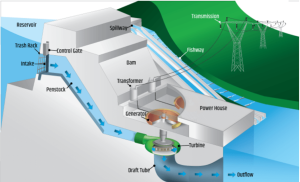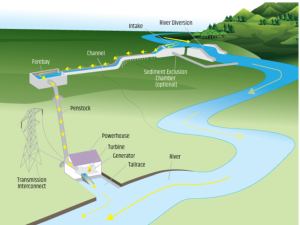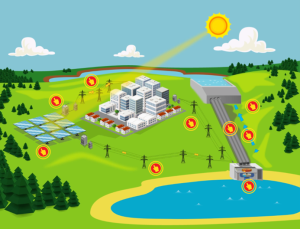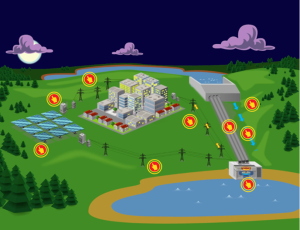Technologies and Facilities
There are three types of hydropower facilities: impoundment, diversion, and pumped storage.
Impoundment systems are the most common type. Impoundment systems use a dam to store river water in a reservoir. When water is released from the reservoir it flows through a turbine which activates a generator to produce electricity.[1]

Source: U.S. Department of Energy[1]
Diversion hydropower systems, also known as “run-of-river” facilities, channel a portion of a river through a canal or penstock to utilize the natural decline of the riverbed elevation to produce energy. A penstock is a closed conduit that channels the flow of water to turbines. A diversion system does not necessarily need a dam to be productive.[2]

Source: U.S. Department of Energy[1]
Pumped Storage hydropower systems (often called PSH) work like a battery. When electricity demand is low (like at night), the PHS facility is able to store the electricity generated by other power sources - like solar, wind, and nuclear - by pumping water from a reservoir at a lower elevation to one at a higher elevation. When electricity demand goes up and the stored power is needed, the water is released back to the lower reservoir, turning a turbine to generate electricity.[3]


Source: U.S. Department of Energy[1]
Hydropower plants can vary in size. A large plant may have a capacity of more than 30 megawatts (MW) and supply energy to many consumers. A small plant may generate anywhere from 100 kilowatts to 10 MW. A micro plant - a plant that generates less than 100 kilowatts – can supply electricity to single home or farm, or a small village. [1]
Types of Hydropower Turbines
The two main types of hydropower turbines are reaction and impulse. The type of turbine used is dependent on the height of standing water and the flow of water over time at the site. Other factors include how deep the turbine must be set, turbine efficiency, and cost.[4]
Reaction turbines generate power from the combined forces of pressure and moving water. A runner is placed in the water stream and the water is allowed to flow over the blades. Reaction turbines are used for sites with lower standing water and higher flows and are the most common type used. Reaction turbine types include Propeller, Francis, and Kinetic.[5]
- Propeller Turbine – has a runner with three to six blades. Water is constantly contacting all of the blades. Different types of propeller turbines are Bulb, Straflo, Tube, Kaplan.[6]
- Francis Turbine – named after its inventor, British-American engineer James Francis, the Francis turbine has a runner with fixed blades in which water is introduced above the runner and then falls through causing the blades to spin.[7]
- Kinetic Turbine – generate electricity from the kinetic energy of naturally flowing water, without requiring diversion. These turbines utilize the natural water flow of rivers, channels, tidal waters, or ocean currents and can make use of existing structures such as bridges, tailraces, and channels.[8]
Impulse turbines use the velocity of water to move the runner. The water stream hits each bucket on the runner and because there is no suction on the downside of the turbine, the water flows out the bottom. These turbines are used for high standing water, low flow applications. The two main types are Pelton and cross-flow.[9]
- Pelton Turbine – has one or more free jets discharging water into an aerated space and impinging on the buckets of a runner.
- Cross-flow Turbine – drum-shaped and uses an elongated, rectangular section nozzle against curved vanes on a cylindrically shaped runner. The water flows through the blades twice.[10]
Updated January 2024 by Tina Allen

Comments are closed.